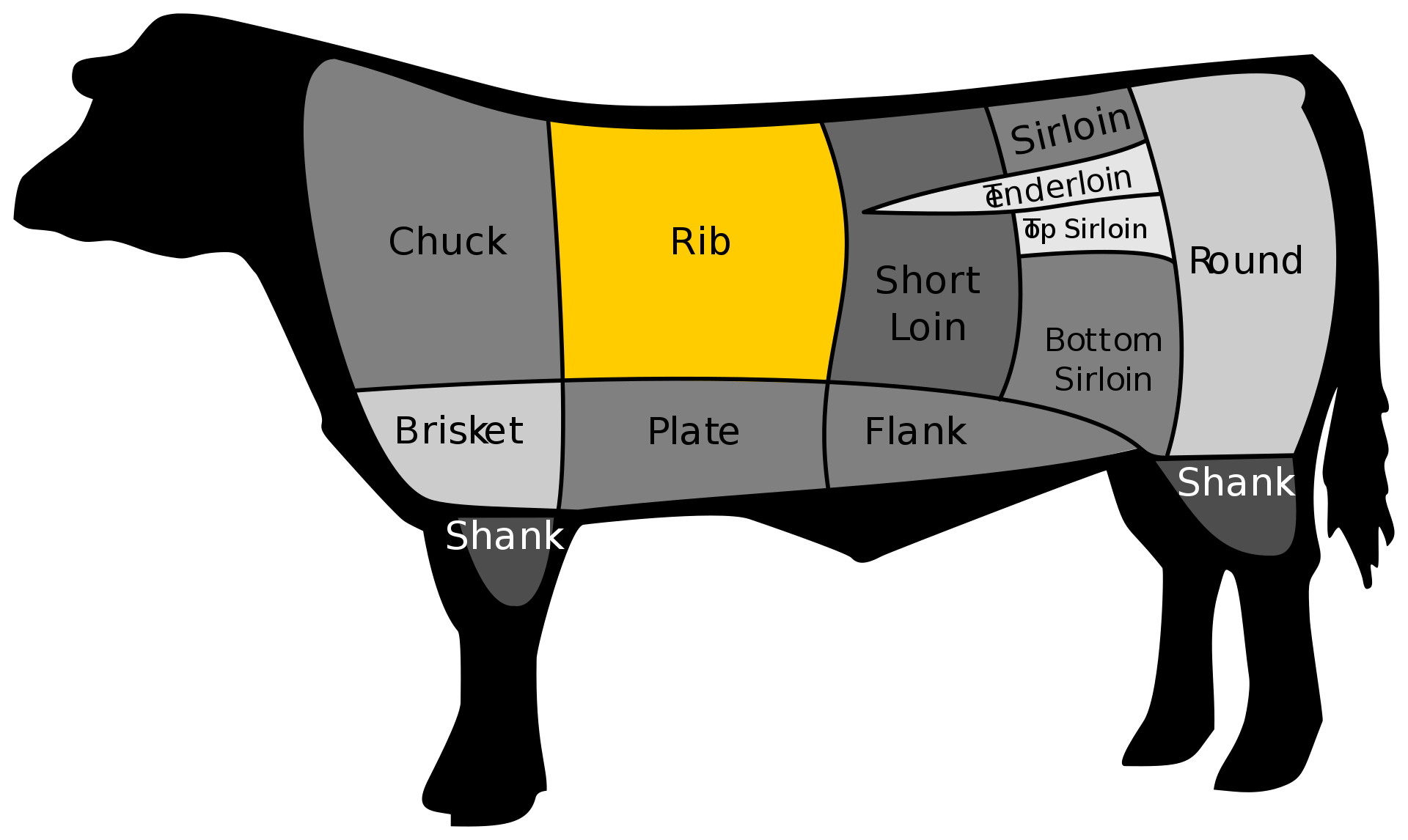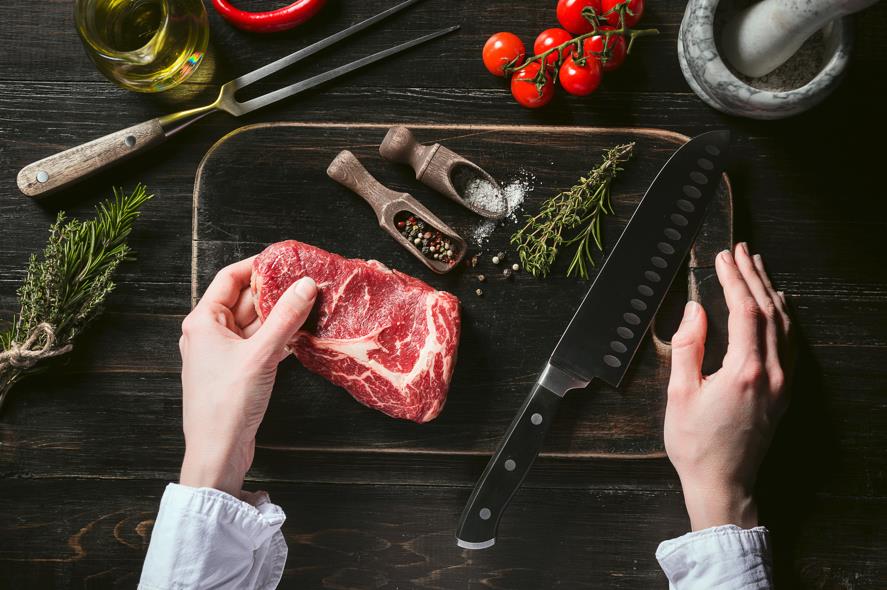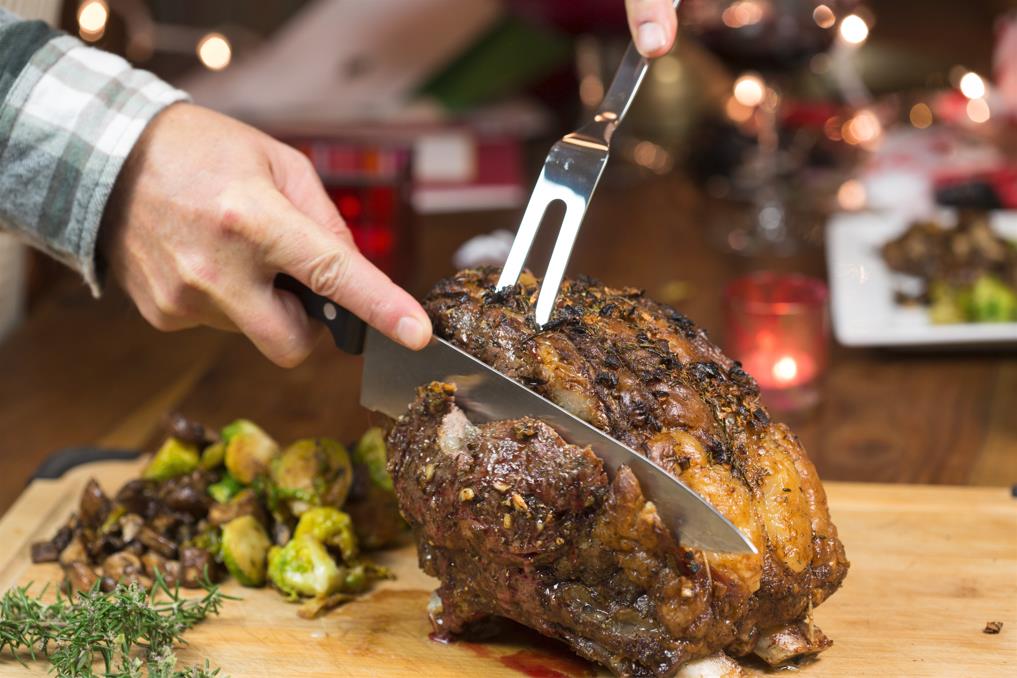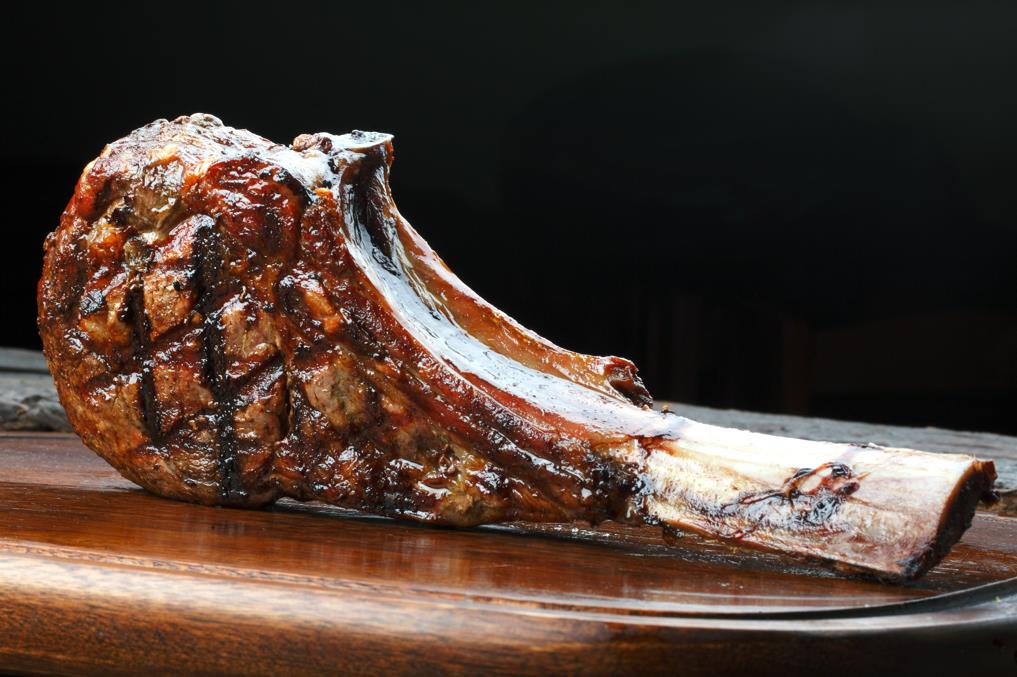Prime Rib is a ‘splurge’ cut of meat that’s made for a special occasion. It’s hefty, singing with beefy flavor, and so impressive when carved.
We’re going to explain prime rib, selecting, and identifying it, how to cut/carve it, and of course how to cook prime rib so that it’s a meal you’ll remember forever!
Table of contents
What is a prime rib?
A prime rib is a cut of beef usually made up of 2 to 7 beef ribs. It’s a part of the beef animal found on its upper side, just behind the shoulder. Because it doesn’t get much exercise, the prime rib is a tender cut of beef – which makes it good eating.
Prime rib has an ‘eye’ of fat that runs through the middle. This breaks down during cooking, anointing the meat with glistening juices!
Here’s a diagram of the prime rib cut on a beef animal so that you can see where it comes from –

At the grocery store, you’ll sometimes find prime rib sold as ‘rib roast’ or ‘standing rib roast’, these are the same thing so don’t be worried by the different label.
Getting the best quality prime rib
- Buy the best quality you can afford: USDA ‘Prime’ or ‘Choice’ grade are both good quality
- Aging of meat plays a significant role in flavor and tenderness: speak to your butcher and aim for prime rib that’s been aged for between 30 and 40 days
- Serving size: buy 1 rib per 2 people served
- Fat content: choose a prime rib with the fat cap/layer still on, and a good and consistent amount of fat marbling throughout the meat
- Bone: buy prime rib with the bone in if you can, the bone adds flavor and moisture to the meat as it cooks
Cutting your prime rib
The tools you’ll need:
- A sharp chef’s knife
- A meat fork AKA chef’s fork
- A sturdy chopping board: if your board moves around, place a damp kitchen towel under it to affix it in place
Handpicked for you
True cutting power in the palm of your hand
Cutting raw prime rib

Cutting down and trimming a whole primal cut into a rib roast, here is how:
If you’ve bought a whole primal cut, it’ll have two ends to the joint. One thinner and with less fat, and one wider and with more fat. Consider serving the thinner end of the meat for a small group of people, and the larger, wider end of the joint for a big group of diners.
- You’re going to place the whole joint on the chopping board in front of you with the ends of the rib bones sticking UP, the meat will be resting on its flatter end.
- Getting a prime rib roast is a process of cutting along the bone. Using your chef’s knife, cut downwards in a long, firm stroke along the edges of the ribs but not cutting into them. You’re cutting down along the bones, parallel to them, to divide the rib section from the roast itself. You want the ribs cut off in one piece, and the roast separate. Try to cut cleanly so that the edge of your roast isn’t jagged or untidy.
- To trim up your rib roast, look at the outside of the roast and using your chef’s knife, cut away any bits of sinew that are still on the meat or hanging off. Sinew is tough so you want to discard those bits. Try to leave as much of the fat on the roast as you can, as this adds juiciness in the cooking process.
Cutting your prime rib into rib-eye steaks, here is the method:
- Place your prime rib joint on your chopping board with the bones pointing UP. Holding the protruding bones firmly with one hand, you’re going to cut with your knife along the edge of the prime rib, following its curve.
- Next, cut away the meat at the base of the ribs where the ribs are connected. This will allow you to pull away the bones from the meat and slice the meat into steaks.
- Decide how thick you want your steaks and cut accordingly. The preferred thickness for rib eye steaks is around 2 inches or slightly thicker.
- If you’re leaving the bones in your rib eye steaks, you’ll need to cut down along each rib bone to separate it from the rib rack. This creates individual rib eyes.
- If you want boneless rib eye steaks, you’ll need to also cut away the rib bones from each steak carefully, following the contour of the bone and not cutting into the actual rib flesh.
Carving a cooked prime rib

- Place your whole prime rib roast on the chopping board so that the bones are facing upwards and towards your non-cutting hand.
- Holding the bones firmly in your non-cutting hand, you’re going to use your knife to cut down in a curve between the meat and the bones. You’ll feel as you go with the side of the knife blade how to follow the curve of the rib bones. If it’s easier at this stage, you can switch to a knife with a longer and thinner blade.
- Now you’ll have a section of rib bones in a chunk that you can cut down along and gently pull away from the rest of the roast. Cut through the connective tissue at the bottom and aim not to saw away at the meat, you want a neat result.
- Once the bone section is pulled away, you’ll be left with a large piece of boneless prime rib that you can slice as you desire for serving. Any fat on the prime rib can be trimmed off at this stage, although it’s best to leave this on for your guests to remove themselves as they might enjoy it.
If you want to cut the boneless prime rib into slices, here is how:
- You’re aiming to cut the meat neatly into ½ inches slices. Hold the prime rib joint firmly in place with your fork or your non-cutting hand, and cut even, consistent slices down through the meat so that it falls apart into attractive slices of roughly ½ inch thick.
- You can cut the slices thinner or thicker if you prefer, just bear in mind that thinner slices will give you more servings per joint.
Note: To keep your prime rib juicy and at best quality, only cut the number of slices that you need to serve immediately. The rest of the joint can be stored safely in a sealed container in the refrigerator for several days or up to a week if the meat is wrapped tightly with cling film.
Cooking prime rib
Prime rib is a wonderful piece of beef for home cooking and here are some recommended cooking guidelines.
Roasting whole prime rib – tried and tested roasting perfection!

- Firstly, preheat your oven to 150F or a bit higher if your oven temperature doesn’t go that low. Basically, you want the lowest temp from 150F upwards.
- Season the prime rib liberally with salt and pepper.
- Place the rib with all the fat layer/fat cap still on it, on an oven rack set into a roasting tray, so that the juices have somewhere to drip into.
- Depending on your oven temperature and performance, your roasting time will range anywhere from 3 ½ to 6 ½ hours.
- Once the roast prime rib has reached the right temperature, remove it from the oven and tent it with foil. Let it sit on the counter, tented, for about an hour.
30 minutes before you plan to eat or your guests arrive, preheat your oven again to its highest temperature – 500F to 550F if possible.
10 minutes before you plan to serve, remove the foil from the prime rib, and place it back in the very hot oven for 6 to 10 minutes until the outside is well browned and slightly crisp. You’ll need to keep an eye on it!
Once the crust/outside of the meat is done to your liking, remove the roast from the oven and you can carve and serve it immediately.
This two-step cooking method gives a beautifully browned ‘crust’ to the meat whilst preserving the juiciness inside and allowing you to get a very specific level of ‘doneness’ to your prime rib roast.
Prime rib FAQs
How long can I keep a raw prime rib roast in the fridge?
If the prime rib is wet aged, it’ll be fine for 3 days in a tightly sealed container. If it’s dry aged, it’ll last up to 3 months in the fridge in a tightly sealed container.
How to safely thaw a frozen prime rib for use quickly?
Take the rib out of the freezer immediately and place it into a large Ziploc bag, seal the Ziploc, then put it inside a large pot in the sink. Submerge the bagged meat in room temperature water, placing something heavy on top to hold it down. Change the water every 30 minutes or so until the meat is thawed.
Is there a way to use the prime rib bones for another meal?
Prime rib bones make a delicious beef stock, so freeze them and use them this way. Warning: beef bones are no good for pets!
In conclusion
Prime Rib is a luxurious beef cut that should be relished now and again. If chosen, cut, and prepared with care, it’ll be the centerpiece of a meal that you’ll remember for years to come.Do join us again for other informative HDMD Knives articles on meat, knife skills, and best butchery practice!












